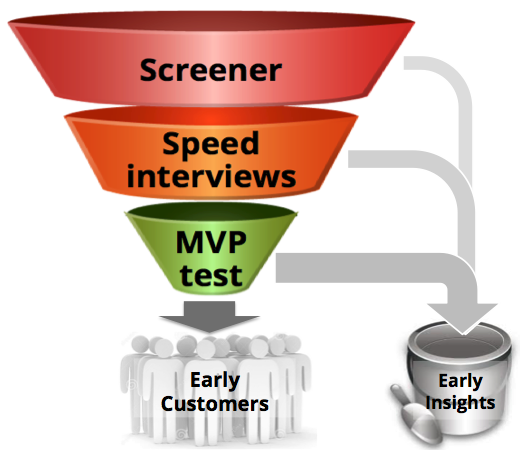Getting to Alpha: 12 Steps to faster, smarter product design
Happy Tuesday! It’s a busy week here at Shufflebrain HQ. We’ve just opened registration for Getting to Alpha – our flagship online coaching program – and we’re busy choosing teams for our Spring 2015 cohort. Later this week I’m heading to New York and Amsterdam to share my learnings about the 7 habits of breakthrough innovators at TNW Europe and Media Future Week – and meetup with smart entrepreneurs and game creators face-to-face.
Some of you have asked me for more detail about the 12 Steps of Getting to Alpha. Here’s am overview of what each step entails, and what we cover in the program.
-
Clarify your product strategy & key assumptions
An effective product experiment starts with clear, testable hypothesis. Using a tool called the MVP Canvas, you will articulate your product, customer & market hypotheses – and then prioritize your key assumptions – the ones that need early testing.
-
Draft your product brief
Sometimes, the best way to create a smart plan is to start at the end and work backwards. You will create a rough draft of your Product Brief – a document that tells the story of what your product is, who it’s for, and how you’ll run your Alpha test.
-
Filter your potential customers
Finding the right early adopters is crucial for your success – and not easy to do. If you’re building something innovative, you need to find a handful of enthusiastic early adopters – and filter out the rest. You’ll use our Early Adopter Screener to identify early customers who NEED what you offer – and will put up with cost, ridicule and friction to get those needs met.
-
Interview your early adopters
Briefly interviewing early customers is a great way to get valuable, actionable input on your product idea and value proposition. You’ll use a technique called Speed Interviews to quickly surface actionable customer insights – and the best testers for your early product.
-
Distill customer insights into Habit Stories
Our research goal is to quickly find out what early customers actually want and need, and use those insights to influence our design choices. You’ll use Job Stories — and their superhero cousin, Habit Stories — as shortcuts for turning customer insights into design-ready stories that will help you drive adoption and engagement by piggybacking on existing habits.
-
Sketch a compelling customer narrative
Digital products — games, apps, services, marketplaces — aren’t static; they evolve over time to fit their audience & environment. To create your stripped-down, high-learning MVP, you’ll sketch out your 4-stage customer narrative with Job Stories that capture how customers will use your product over time.
-
Design an engaging Core Loop
A compelling Customer Narrative is built around an activity your customers can get better at. You’ll design a simple & compelling Core Loop for customers who’ve learned the ropes – and now want to stay engaged, improve their skills, and get value from their experience.
-
Build a low-fidelity prototype
The goal of your product experiment is to collect actionable feedback on your key assumptions. You’ll create a simple, stripped-down prototype of your Core Loop that can test your value proposition and key assumptions.
-
Test your prototype with early adopters
Choosing the right people for a low-fidelity MVP test is critical. Many people cannot offer useful feedback on early designs.You;ll test your prototype with the early adopters you filtered and vetted earlier, using our 3-part MVP Test – and get actionable customer insights you can trust.
-
Validate your product strategy & key assumptions
After testing, you’ll leverage what you’ve learned – and create an MVP Canvas BEFORE & AFTER to validate your product strategy and update your key assumptions. This is the LEARN part of the Build/Measure/Learn loop – when you turn early customer data into product design decisions.
-
Iterate your Narrative & Core Loop loop
Once you’ve updated your product strategy and generated a new set of assumptions, you’ll put those customer insights to work and iterate your product design by updating and mocking up screens for your Customer Narrative and Core Loop
-
Update your Product Brief
Now we’re back where we started – with powerful new insights & real customer data. You’ll synthesize and communicate what you’ve learned by updating your Product Brief with strategy, design and customer insights – and an updated, research-informed plan for Getting to Alpha.
 If this sounds like what you and your team needs to accelerate your design process, check out our program and signup for a free consultation.
If this sounds like what you and your team needs to accelerate your design process, check out our program and signup for a free consultation.